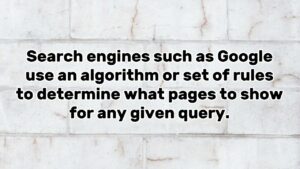
Search engine Optimization can be a complex and scary topic. Endless opportunities to advertise and market, constantly changing trends and technologies, and overly complex solutions all come with the territory. So, what you don’t need when you’re evaluating or creating your search engine marketing strategy is lengthy explanations about how different techniques work. Instead, seek out advisors who can guide you with simple explanations and techniques based on real results. That’s exactly what following article is about. It’s a simple list of four things business owners can use in creating or evaluating their search engine marketing strategy.
Establish Your Internet Marketing Strategy Goal.
Many consultants will tell you to set goals about what you want to achieve with your website. Forget it. Those are distractions from the real question you need to ask yourself, which is
“What is THE purpose of my website?”
Once you answer that question, all other aspects of search engine marketing strategy can be leveraged to help you achieve that purpose. Typically, people use their website for many different purposes. Regardless, you still need to answer this question. The focus you will get from it will help you create a more effective strategy.
Here are the top three most common answers to the question “What is THE purpose of my website?”
1. To sell things
2. To generate leads for my sales team
3. To educate my target audience
It can be this simple! Just decide which of the three answers above suits you best (or create your own) and then move on to step 2.
2. Establish a Search Engine Marketing Plan
There’s a reason why search engine marketing is so hot. It works. It consistent generates leads, sales, etc. at a lower cost-per-lead or cost-per-sale than traditional mediums like TV or direct mail advertising. It makes sense when you think about it: when people want to find something online, they go to Google, Yahoo!, MSN, etc. and search for it.
Search engine marketing is all about SHOWING UP when people search for what you sell, offer, or have on your website. There is a growing body of knowledge (books, articles, etc.) on how to do this. And like anything else, it has become over analyzed and too complex. To further complicate things, some search engine marketing techniques are ethical and legitimate, while some are not. The best approach is to create a search engine marketing plan that focuses on two aspects:
1. Search engine optimization – showing up in the “free” area of the search engine’s results
2. Pay-per click advertising – showing up in the “paid” area of the search engine’s results
For search engine optimization, first realize there is no “silver bullet.” There just isn’t a way to easily get ranked consistently high in the search engines. It is a combination of factors that always come down to one underlying truth: build your website according to web standards, with a focus on accessibility for all.
Conduct Search Engine Optimization (SEO)
The goal of search engine optimization is to make changes to your website to get higher rankings in search engines. Yet, search engine optimization is a confusing sector. On one hand, there are “snake oil salesmen” ready to get you a #1 ranking with their latest trick. On the other hand, the things that actually do work are very simple, and frankly, just not very “sexy.”
Here’s a sample list of SEO standards to enforce on your website:
1. Write descriptive HTML page titles that really describe the page it is on (in 255 characters or less)
2. Write a summary sentence that really describes the page it is on (in 255 characters or less)
3. Write page content that is focused on
4. Write descriptive ALT text for all images that describes the concept the image illustrates and never use images for text
5. Build all pages to comply with current web standards observed by the World Wide Web Consortium (W3C)
4. Leverage Pay-Per Click Advertising
Pay-per click advertising helps you get more traffic from search engines through advertising in search engine results. You pick terms that people search on. You bid a price per click on your ad that you are willing to pay. You ad shows up when someone searches on that term, and, if you’re lucky, they click on your ad and come to your website.
So, pay-per click advertising really boils down to 3 components:
1. Picking keywords to advertise on (i.e. target keywords)
2. Determining what to bid for those target keywords
3. Writing copy for the ads that show up when people search
By following the approach above, you can create or evaluate your search engine marketing strategy, focus on what matters most when executing your plans, and more effectively achieve your goals.
source






